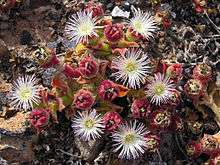Mesembryanthemum crystallinum
| Common iceplant | |
|---|---|
 | |
| Mesembryanthemum crystallinum flowering in Lanzarote | |
| Scientific classification | |
| Kingdom: | Plantae |
| (unranked): | Angiosperms |
| (unranked): | Eudicots |
| (unranked): | Core eudicots |
| Order: | Caryophyllales |
| Family: | Aizoaceae |
| Subfamily: | Mesembryanthemoideae |
| Genus: | Mesembryanthemum |
| Species: | M. crystallinum |
| Binomial name | |
| Mesembryanthemum crystallinum L. | |
| Synonyms | |
|
Cryophytum crystallinum (L.) N.E.Br. | |
Mesembryanthemum crystallinum is a prostrate succulent plant native to Africa, Sinai and southern Europe, and naturalized in North America, South America and Australia.[1] The plant is covered with large, glistening bladder cells or water vesicles, reflected in its common names of common ice plant, crystalline ice plant or ice plant.[1] The bladder cells are enlarged epidermal cells. The main function of these bladder cells is to reserve water.[2] It can be annual, biennial or perennial, but its life cycle is usually completed within several months, depending on environmental conditions.[2]

Habitat
Mesembryanthemum crystallinum is found on a wide range of soil types, from well-drained sandy soils (including sand dunes), to loamy and clay soils. It can tolerate nutritionally poor or saline soils. As with many introduced species it also grows in disturbed sites such as roadsides, rubbish dumps and homestead yards.[2]
Biology
The plant usually uses C3 carbon fixation, but when it becomes water- or salt-stressed, it is able to switch to Crassulacean acid metabolism.[3] Like many salt-tolerant plants, M. crystallinum accumulates salt throughout its life, in a gradient from the roots to the shoots, with the highest concentration stored in epidermal bladder cells. The salt is released by leaching once the plant dies. This results in a detrimental osmotic environment preventing the growth of other, non-salt-tolerant species while allowing M. crystallinum seeds to germinate.[2]
Mesembryanthemum crystallinum flowers from spring to early summer . Flowers open in the morning and close at night, and are insect pollinated.[2]
In M. crystallinum, the number of seeds produced depends on whether CAM has been activated (C3 metabolism is more efficient) and the size the plant has grown to in its juvenile growth phase. During seed production, older portions of the plant progressively die off and dry out. The developing seed capsules continue to sequester salt and produce viable seeds. Seeds at the top of the capsule generally germinate immediately on imbibation while seeds at the base may remain dormant for longer than four weeks.[2]

Uses
Its leaves are edible, as with some other members of the Aizoaceae family. Seeds can also be eaten. The crushed leaves can be used as a soap substitute and has some medicinal uses. It is rarely, if ever, grazed upon by domestic stock.[2]
It is also cultivated for ornamentation.[1]
Due to its salt accumulation, M. crystallinum may be useful for bio-remediation[2]
References
- 1 2 3 "Taxon: Mesembryanthemum crystallinum L.". Germplasm Resources Information Network (GRIN). United States Department of Agriculture, Agricultural Research Service, Beltsville Area. Retrieved 2008-01-01.
- 1 2 3 4 5 6 7 8 "Mesembryanthemum crystallinum L.". Water for a Healthy Country. CSIRO. Retrieved 2014-04-14.
- ↑ Tallman, Gary; Zhu, Jianxin; Mawson, Bruce T.; Amodeo, Gabriella; Nouhi, Zepedeh; Levy, Kathleen; Zeiger, Eduardo (1997). "Induction of CAM in Mesembryanthemum crystallinum Abolishes the Stomatal Response to Blue Light and Light-Dependent Zeaxanthin Formation in Guard Cell Chloroplasts". Plant and Cell Physiology. 38 (3): 236–42. doi:10.1093/oxfordjournals.pcp.a029158.
| Wikimedia Commons has media related to Mesembryanthemum crystallinum. |